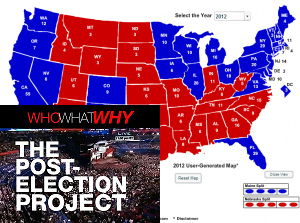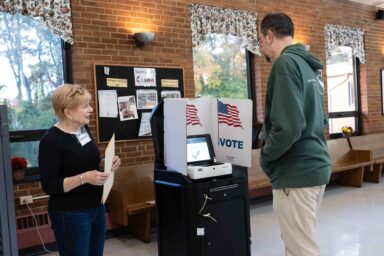Replacing the controversial and disenfranchising Electoral College with a straight national popular vote sounds impossible. Or is it? Under the radar, an effort to create a national vote may be on its way to eventual success.
 Now that the election’s over, this is a great time to forget about ideas for reforming the electoral system.
Now that the election’s over, this is a great time to forget about ideas for reforming the electoral system.
Er, that’s a joke. Obviously, this is exactly the right moment to have a serious discussion—and concrete action—on making the system work better.
That’s highly unlikely to happen unless citizens of all stripes—the ones who make almost everything meaningful happen, when they can muster the interest and energy—take the lead.
One person who is doing just that is a fellow in Silicon Valley by the name of John Koza.
I met him shortly after I had written an article about ways of invigorating our elections process, and was intrigued and impressed.
Koza is the father of the movement for a National Popular Vote. It would replace the current system, in which the presidential candidate with the most votes can still lose, based on the complex formula of the Electoral College, and its tendency to winner-take-all on a state by state basis. National Popular Vote is a simple concept: whoever gets the most total votes of all cast throughout the United States—wins.
Now, you might assume that this will never come to pass, in part because it is so hard to amend the constitution and get rid of the Electoral College.
In fact, it turns out to be surprisingly easy. The kind of thing that would occur to a Silicon Valley pioneer—the computer scientist who among other inventions is credited with conceiving the scratch-off card (for lotteries and other contests).
Koza and his cohorts have come up with a brilliant solution to the disenfranchisement that the Electoral College represents. It doesn’t even require a constitutional amendment. Article II, Section 1 of the U.S. Constitution gives each state legislature the right to decide how to appoint the state’s electors. So all it would take is for the legislatures of states representing a majority of electoral votes to pass laws binding their states to abide by the results of the national popular vote. That is, the candidate with the most popular votes nationwide would automatically be awarded all of the electoral votes from the consenting states. Once enough states–which, combined, control 270 electoral votes–sign on to this agreement, the Electoral College would, de facto, be overridden.
Those consenting states don’t need some kind of centralized authority to do this—each legislature can make the decision on its own. And nine states have already signed on to the National Popular Vote Interstate Compact (NPVIC). (At that link, you can read about all sorts of issues that come up, such as whether states can legally make such compacts—Answer: probably)
In order of adoption date, Maryland, New Jersey, Illinois, Hawaii, Washington, Massachusetts, District of Columbia, Vermont, and California have joined NPVIC. Together, they represent 132 electoral votes, or a little less than half of the 270 needed to make the compact the final word in elections. A chart shows other states which have gone partway, with a Compact bill passing at least one house of the legislature.
Now, it is true that the person with the most popular votes actually has garnered the most electoral votes and been installed in the White House in 51 out of 55 elections. But even assuming those four exceptions don’t trouble you, it’s worth considering another issue: How the current Electoral College makeup distorts the campaigns themselves.
If every vote were to count equally, presidential candidates would no longer ignore huge Blue states like California and New York (as anything other than campaign-donor hunting grounds); the change would also benefit hard-Red states whose Presidential returns are also foregone conclusions, like Mississippi and Wyoming. So it’s not a matter of small states getting ignored. It just shifts the attention of political parties and the media from a handful of swing states to an appeal to all Americans. Suddenly, issues like public transportation, which matter most in major urban areas, gain the spotlight. Ditto with rural internet, which is a lifeline in sparsely-populated areas whose numbers are more substantial when nationally represented.
No one can predict with certainty how future legislative agendas might change under NPVIC. But we know how the current Electoral College works, and it’s a far cry from the presumed democratic ideal of “one person, one vote” — which NPVIC would surely advance.
Hard to see how that isn’t a good idea. The fact that Koza, a Democrat, has mostly Republicans on his committee demonstrates that this isn’t—and needn’t be—a partisan issue.
You can find more info at National Popular Vote’s website.
# #


